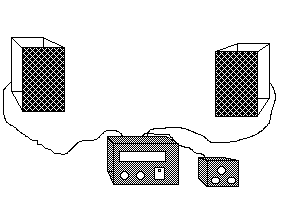Interference--Stereo Speakers
From UO Physics Demonstration Catalog
Revision as of 09:37, 13 April 2022 by Physdemo (talk | contribs) (Created page with "{{NewDemo|subject=OWS|topic=Waves|file1=Interference-Stereo Speaker.gif}} A common signal is sent to two speakers. One speaker is hooked through switch that changes the phase of one speaker by 180 degrees. At low frequencies, 50hz, students are asked in which position does the signal sound louder. Alternative: When two speakers wired out of phase are placed facing each other you will get substantial cancellation of sounds where the wavelengths are greater than the 3-4c...")
Return to Waves
Description:
A common signal is sent to two speakers. One speaker is hooked through switch that changes the phase of one speaker by 180 degrees. At low frequencies, 50hz, students are asked in which position does the signal sound louder.
Alternative: When two speakers wired out of phase are placed facing each other you will get substantial cancellation of sounds where the wavelengths are greater than the 3-4cm (f>8.5khz) distance between the two speakers. Due to the angular dispersion of the sounds, shorter wavelengths will not be cancelled as much due to the constructive interference that is occurring at angles that are off axis. These high frequencies are still cancelled between the speakers. Reverse the polarity so the speakers are in phase and the bass becomes much more pronounced as we now have constructive interference between the two speakers. Again set the speakers so the signals are out of phase and slowly separate the speakers. Off axis wave addition will continue and the music will become louder as the midrange frequencies are constructively adding at angles off the axis line between the two speakers. Continue the separation and the bass notes will become more pronounced.
Separate and turn the speakers so they face the class and you should also be able to map out an interference pattern in the classroom by asking students to raise their hands when the bass coming from the speakers is the loudest, in position 1 or 2 (Out of Phase, in Phase). I would expect that you will get the center of the class raising their hands for the in phase position. Students off to the side may choose the out of phase position depending on how the sounds are bouncing around the room. This teaches the students why polarity needs to be observed when connecting speakers.
Location:
- Speakers: Audio/speaker cart (by fume hood)
- Frequency Generator: Shelf C-2
- Amplifier: Audio/speaker cart (by fume hood)
